
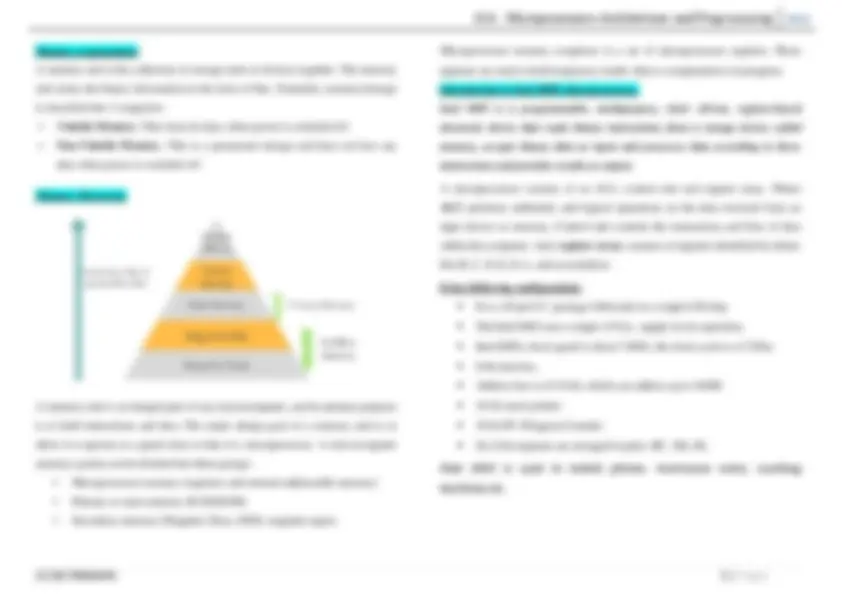
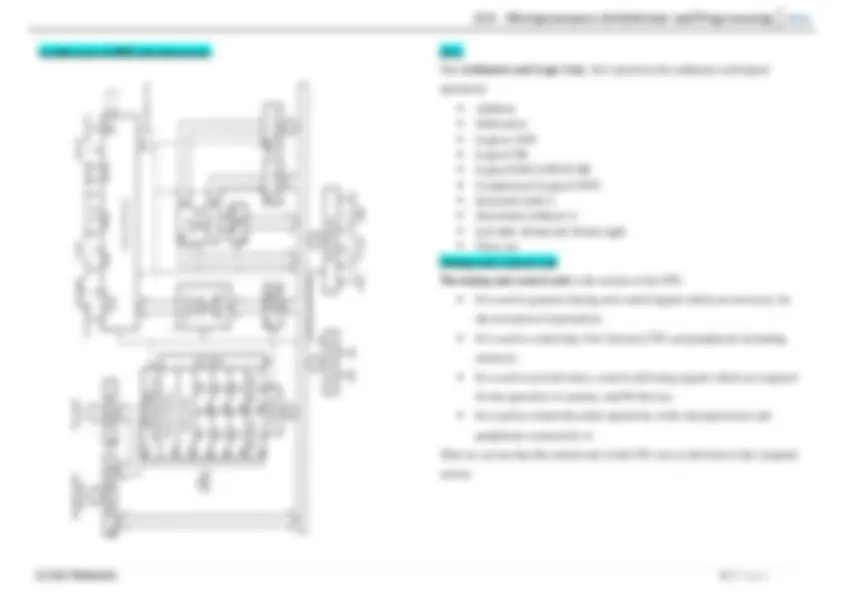
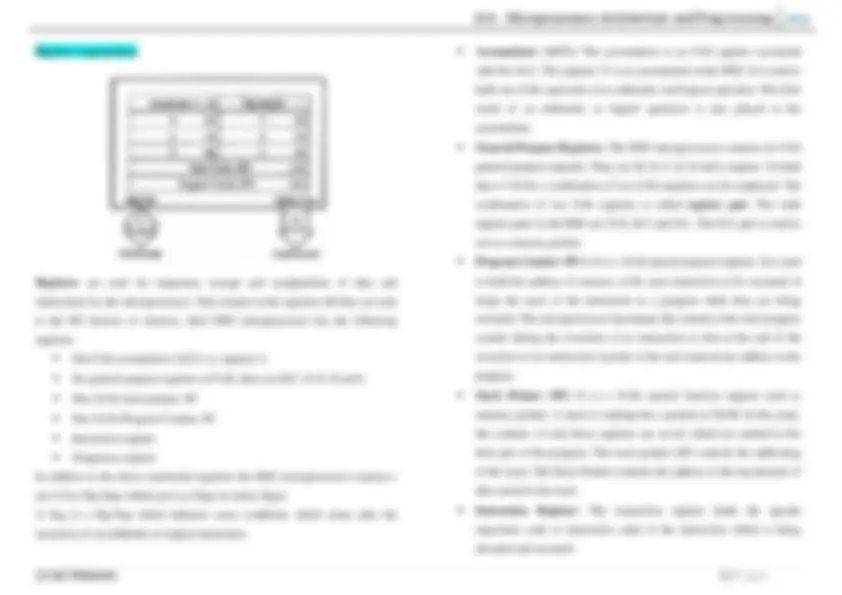
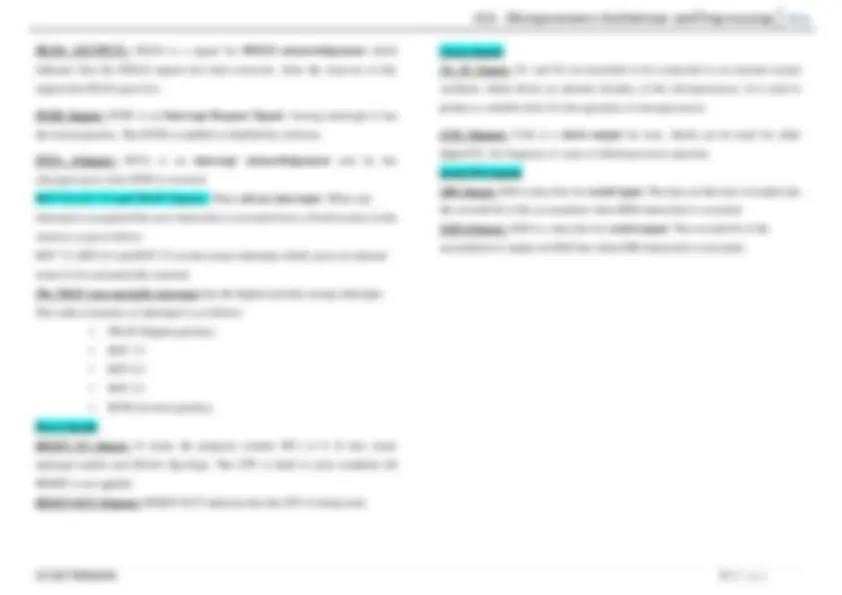
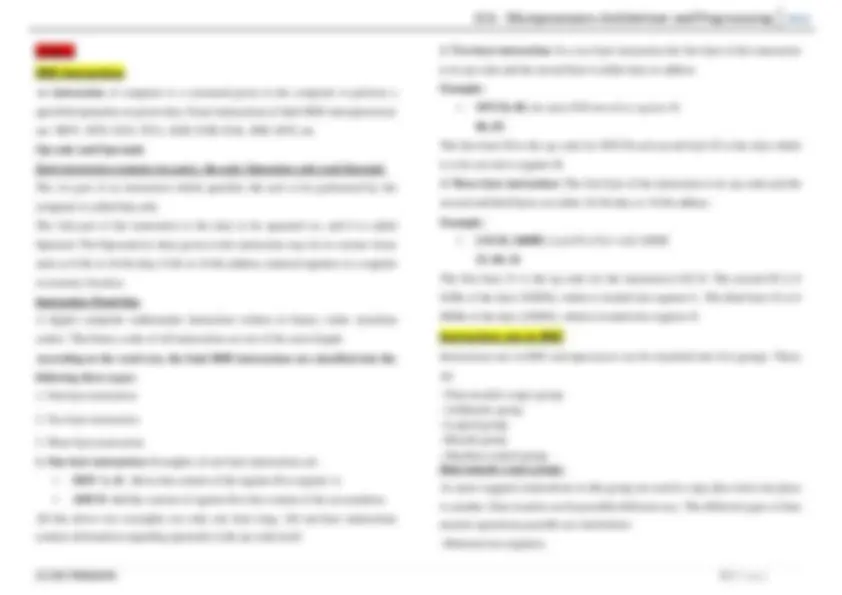
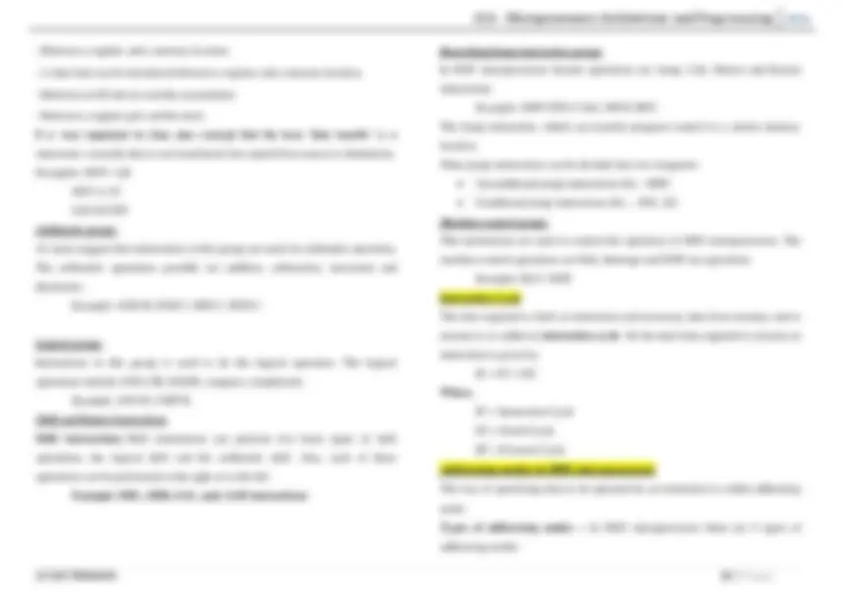
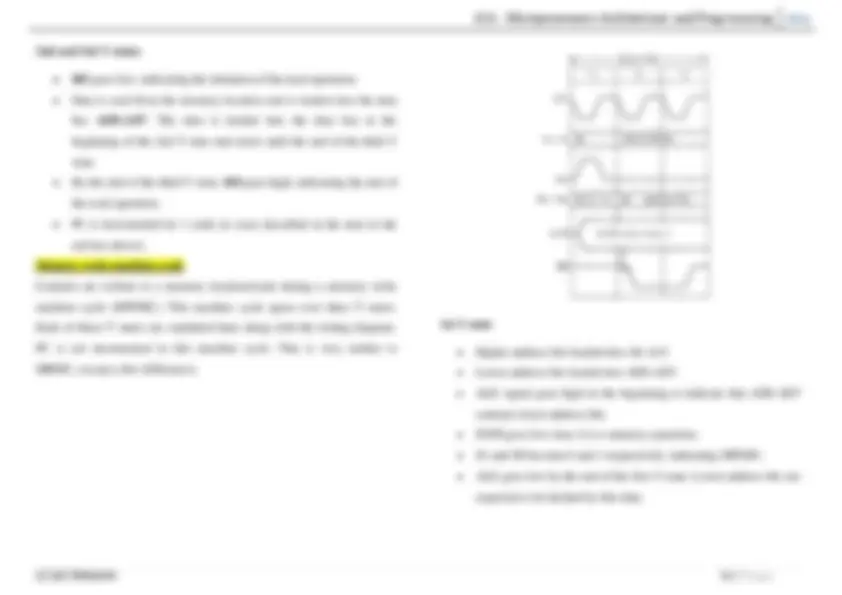
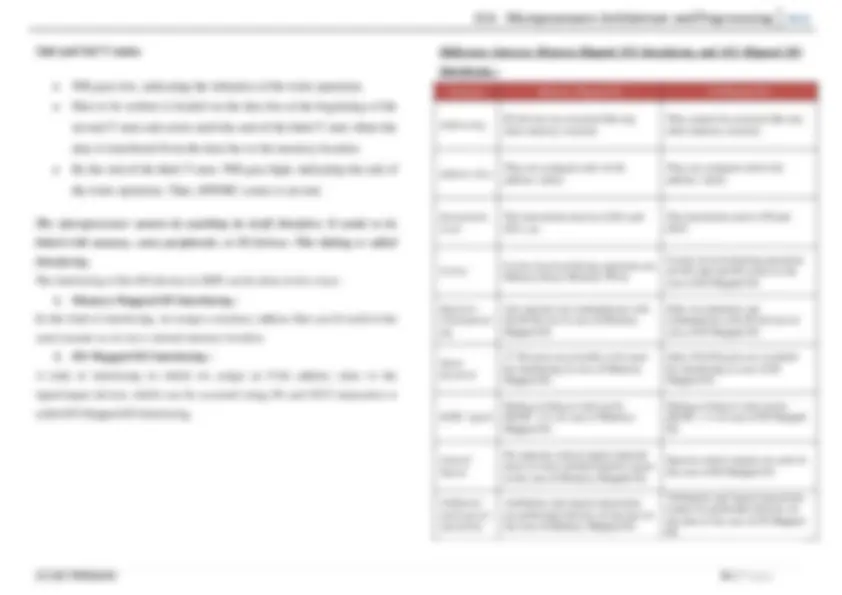
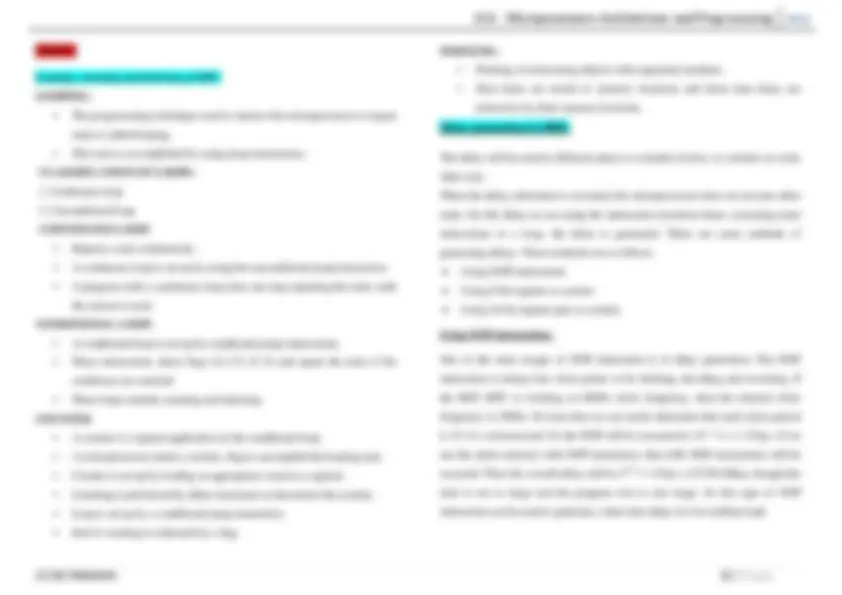
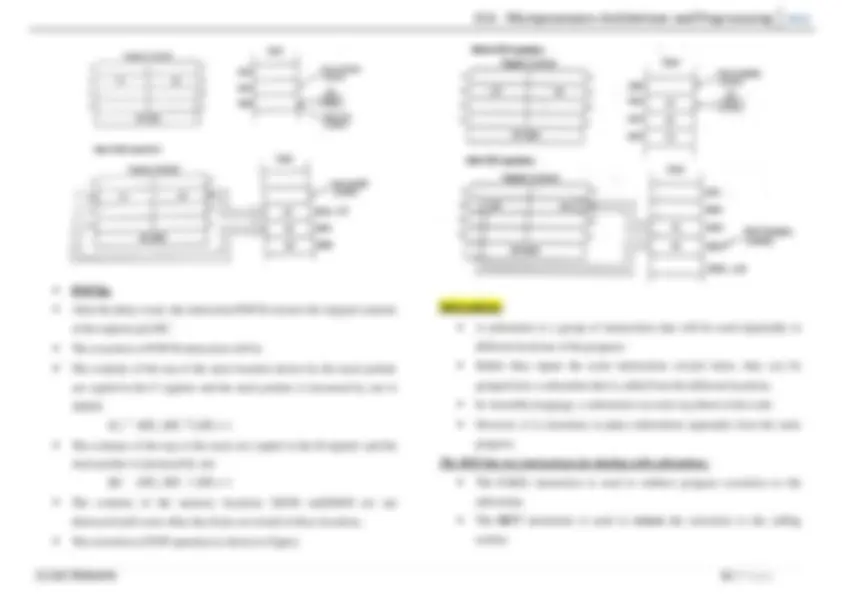
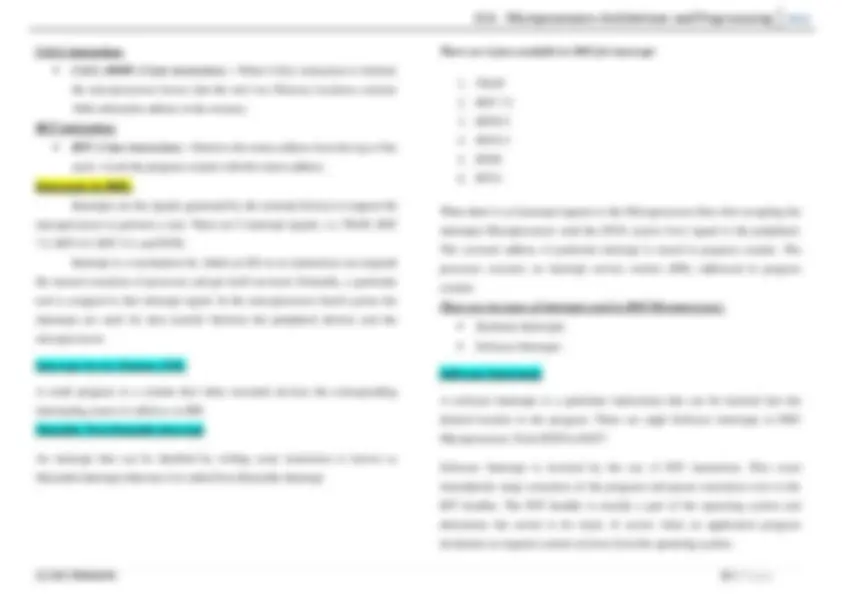
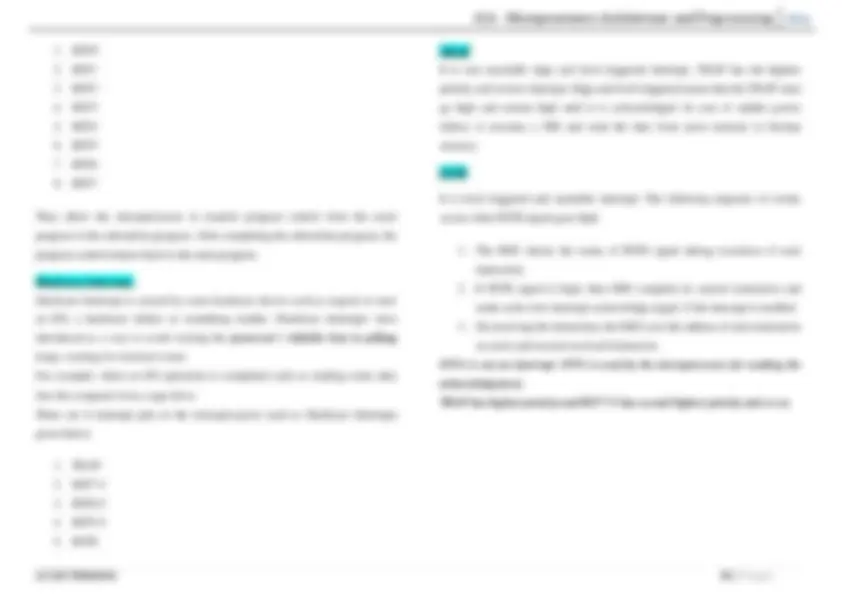
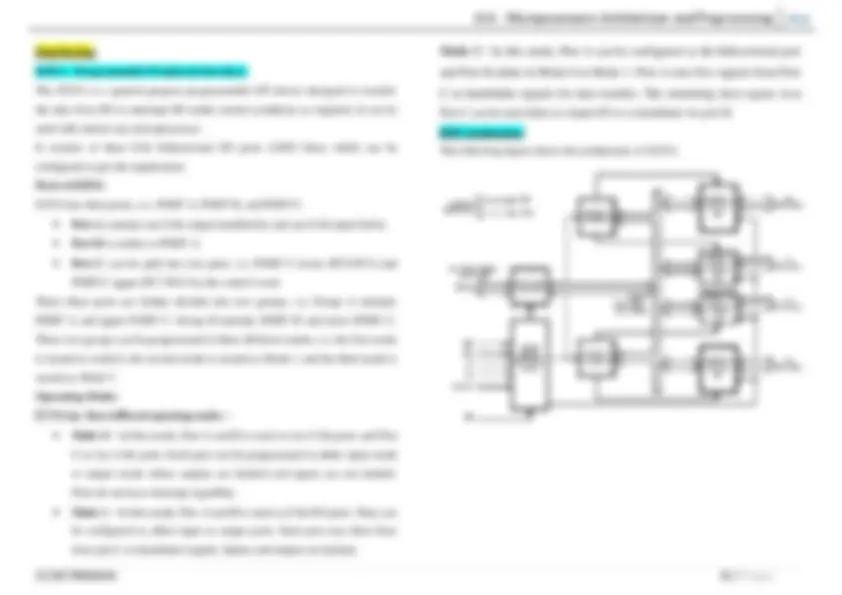
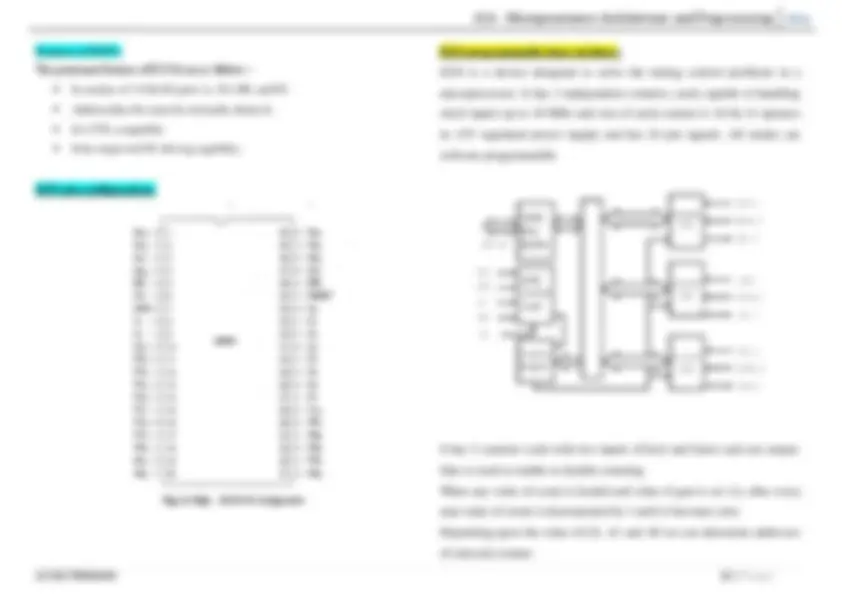
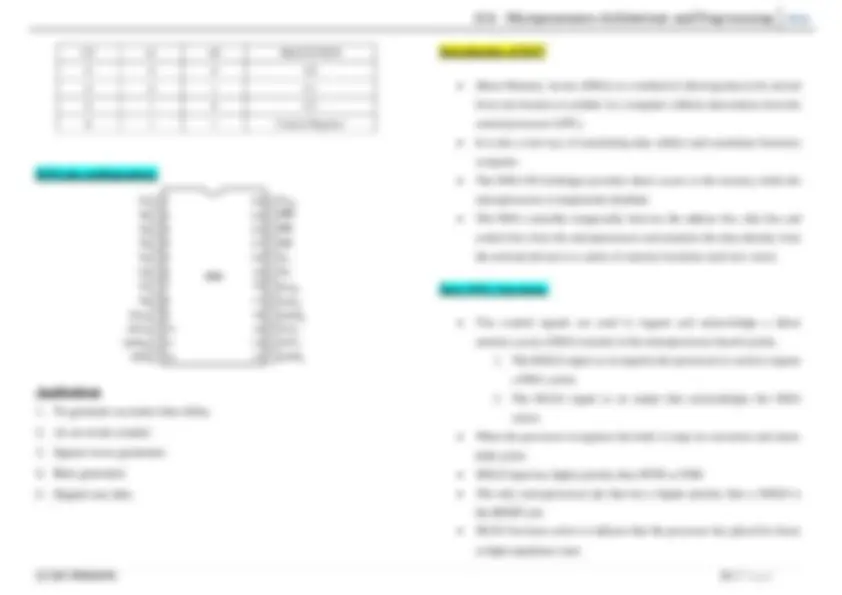
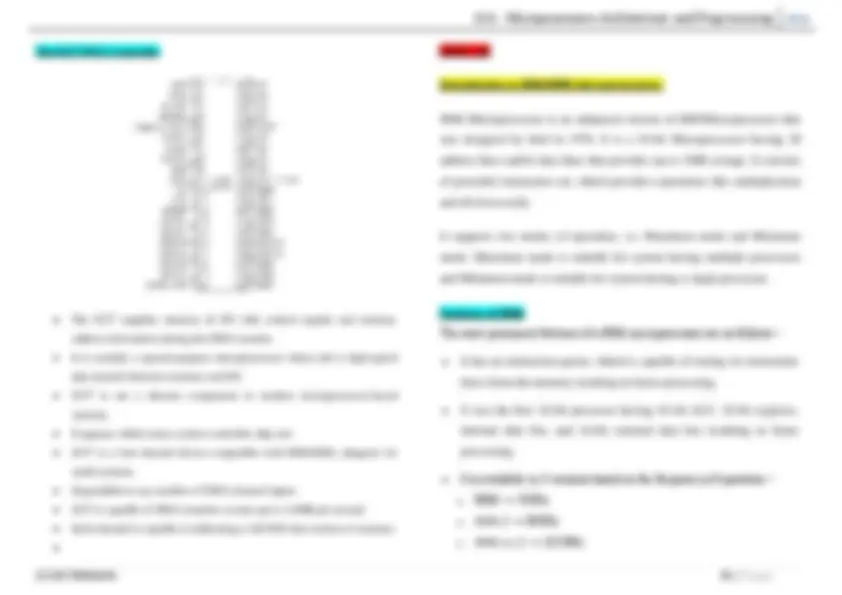
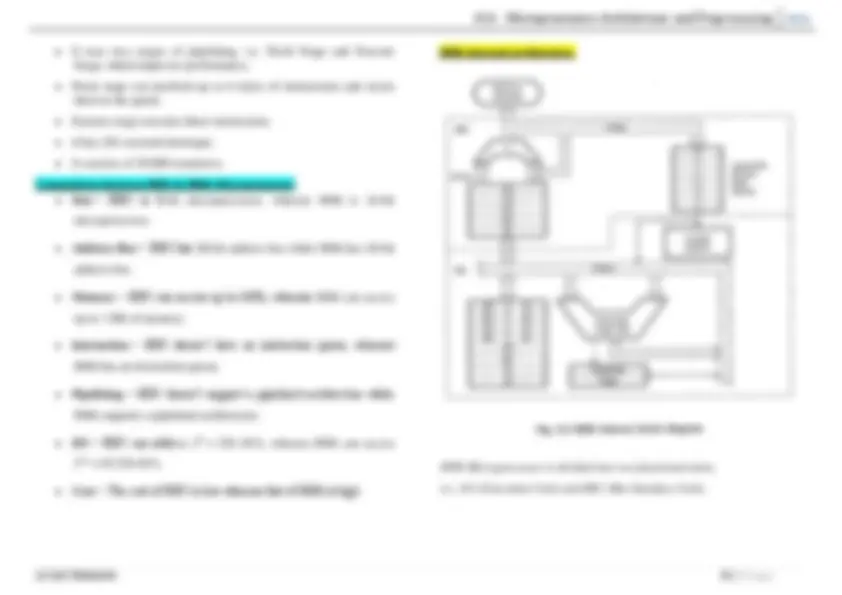
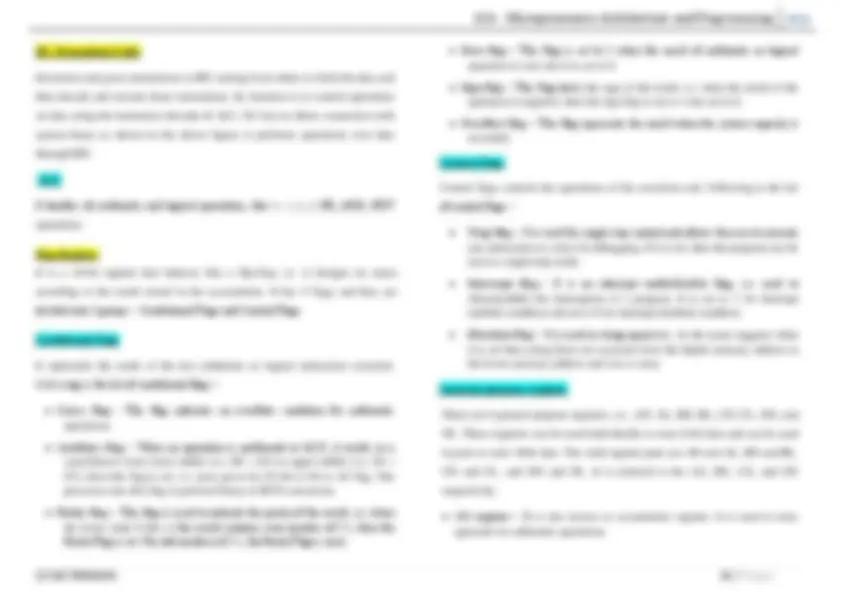
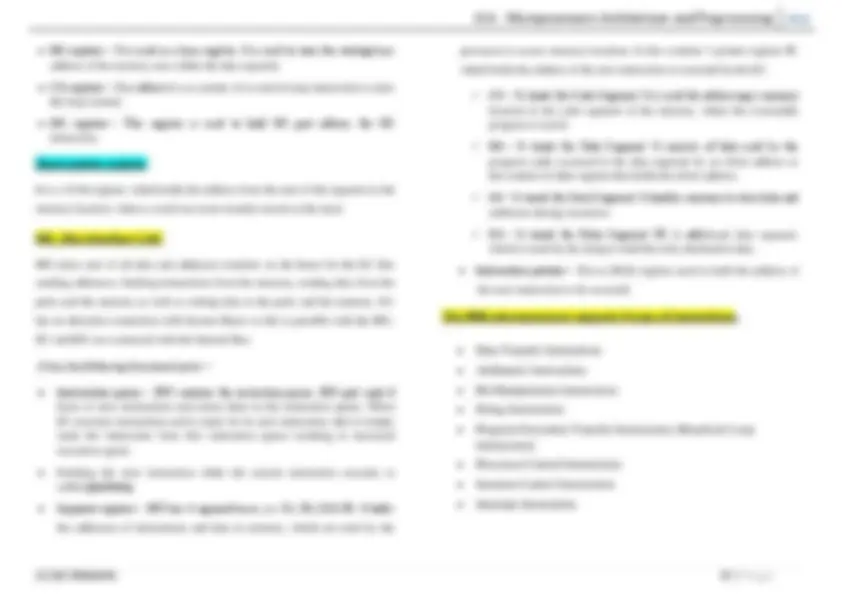
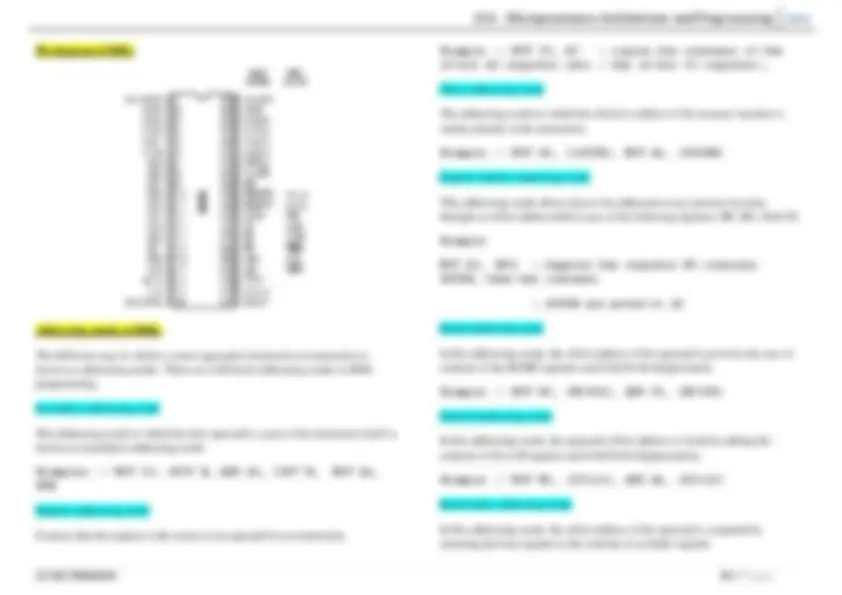
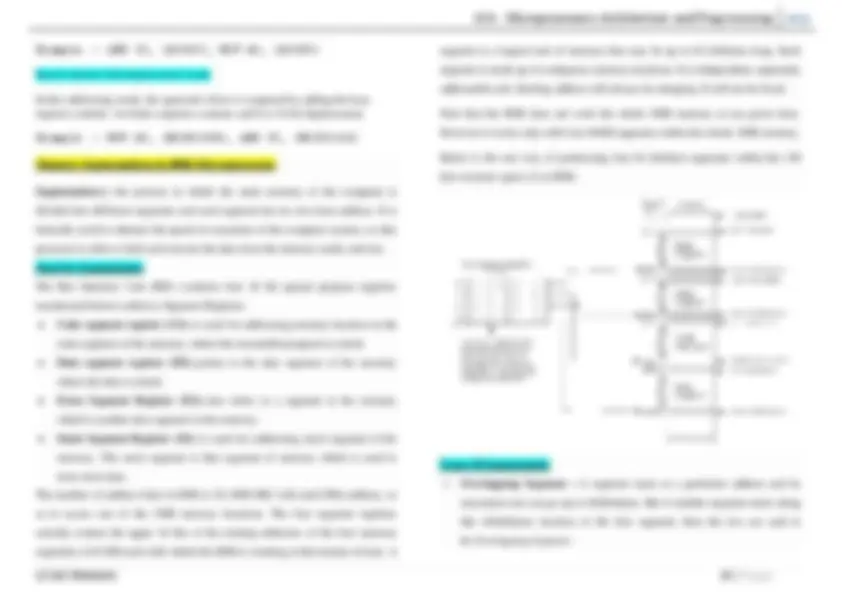
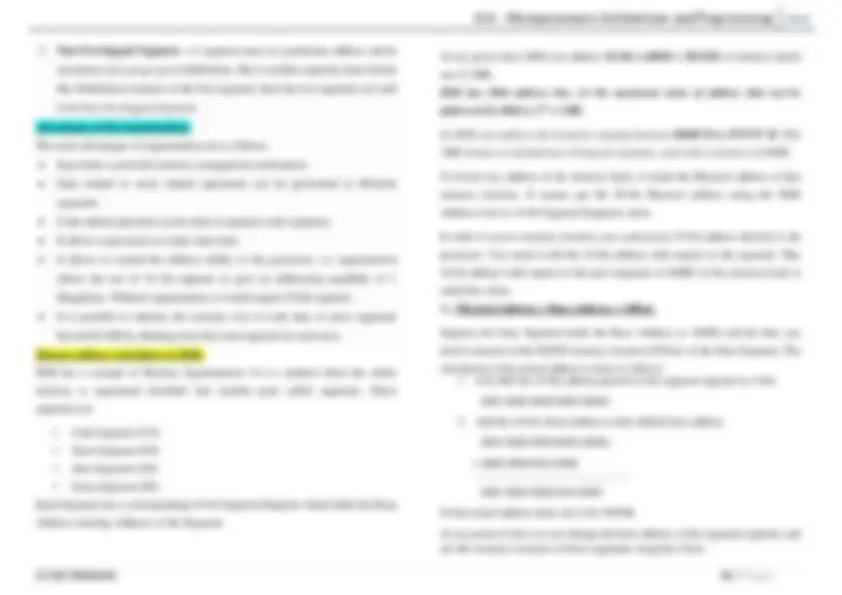



Study with the several resources on Docsity

Earn points by helping other students or get them with a premium plan


Prepare for your exams
Study with the several resources on Docsity

Earn points to download
Earn points by helping other students or get them with a premium plan
Community
Ask the community for help and clear up your study doubts
Discover the best universities in your country according to Docsity users
Free resources
Download our free guides on studying techniques, anxiety management strategies, and thesis advice from Docsity tutors
An overview of the architecture and programming of the 8085 microprocessor, including its memory hierarchy, register organization, bus organization, instruction set, and addressing modes. It covers topics such as the microprocessor's components, data and address buses, control signals, instruction cycles, and common instructions used in programming. The document also compares the 8085 microprocessor to the 8086 microprocessor, highlighting differences in memory access, execution units, and instruction sets. This information would be useful for students studying computer architecture, digital electronics, or microprocessor-based system design at the university level.
Typology: Lecture notes
1 / 31

This page cannot be seen from the preview
Don't miss anything!
























B.Sc Computer Science (CUCBCSS) - (2019 admission onwards) Fourth semester COMMON COURSE
Pradeep C P ( M.Sc,,M.Phil ) Assistant professor (Electronics) Le-Ment College Of Advanced Studies. (Affiliated to Calicut University) Pattambi Palakkad
Block Diagram of a Microcomputer:
Architecture of 8085 microprocessor ALU The Arithmetic and Logic Unit , ALU performs the arithmetic and logical operations: Addition Subtraction Logical AND Logical OR Logical EXCLUSIVE OR Complement (Logical NOT) Increment (add 1) Decrement (subtract 1) Left shift, Rotate left, Rotate right Clear, etc. Timing and Control Unit The timing and control unit is the section of the CPU. It is used to generate timing and control signals which are necessary for the execution of instructions. It is used to control data flow between CPU and peripherals (including memory). It is used to provide status, control and timing signals which are required for the operation of memory and I/O devices. It is used to control the entire operations of the microprocessor and peripherals connected to it. Thus we can see that the control unit of the CPU acts as the brain of the computer system.
Register organization Registers are used for temporary storage and manipulation of data and instructions by the microprocessor. Data remain in the registers till they are sent to the I/O devices or memory. Intel 8085 microprocessor has the following registers: One 8-bit accumulator (ACC) i.e. register A Six general purpose registers of 8-bit, these are B,C, D, E, H and L One 16-bit stack pointer, SP One 16-bit Program Counter, PC Instruction register Temporary register In addition to the above mentioned registers the 8085 microprocessor contains a set of five flip-flops which serve as flags (or status flags). A flag is a flip-flop which indicates some conditions which arises after the execution of an arithmetic or logical instruction. Accumulator (ACC): The accumulator is an 8-bit register associated with the ALU. The register 'A' is an accumulator in the 8085. It is used to hold one of the operands of an arithmetic and logical operation. The final result of an arithmetic or logical operation is also placed in the accumulator. General-Purpose Registers: The 8085 microprocessor contains six 8-bit general purpose registers. They are: B, D, C, E, H and L register. To hold data of 16-bit a combination of two 8-bit registers can be employed. The combination of two 8-bit registers is called register pair. The valid register pairs in the 8085 are: D-E, B-C and H-L. The H-L pair is used to act as a memory pointer. Program Counter (PC): It is a 16-bit special purpose register. It is used to hold the address of memory of the next instruction to be executed. It keeps the track of the instruction in a program while they are being executed. The microprocessor increments the content of the next program counter during the execution of an instruction so that at the end of the execution of an instruction it points to the next instructions address in the program. Stack Pointer (SP): It is a 16-bit special function register used as memory pointer. A stack is nothing but a portion of RAM. In the stack, the contents of only those registers are saved, which are needed in the later part of the program. The stack pointer (SP) controls the addressing of the stack. The Stack Pointer contains the address of the top element of data stored in the stack. Instruction Register: The instruction register holds the opcode (operation code or instruction code) of the instruction which is being decoded and executed.
Control bus : which is used to generate timing and control signals to control all the associated peripherals, microprocessor uses control bus to process data that is what to do with selected memory location. Some control signals are: Memory read Memory write I/O read I/O Write Op-code fetch 8085 - Pin Configuration Address Bus and Data Bus A8 to A15 (Output): These are address bus and are used for the most significant bits of the memory address or 8-bits of I/O address. AD0 to AD7 (Input/output): These are time multiplexed address/data bus i.e. they serve dual purpose. They are used for the least significant 8 bits of the memory address or I/O address during the first cycle. Again they are used for data during 2nd and 3rd clock cycles. Control and Status Signals ALE (Output): ALE stands for Address Latch Enable signal. ALE goes high during first clock cycle of a machine cycle and enables the lower 8-bits of the address to be latched either into the memory or external latch. IO/M (Output): It is a status signal which distinguishes whether the address is for memory or I/O device. S0, S1 (Output): These are status signals sent by the microprocessors to distinguish the various types of operation given in table below: RD (Output): RD is a signal to control READ operation. When it goes low, the selected I/O device or memory is read. WR (Output): WR is a signal to control WRITE operation. When it goes low, the data bus' data is written into the selected memory or I/O location. READY (Input): It is used by the microprocessor to sense whether a peripheral is ready to transfer a data or not. If READY is high, the peripheral is ready. If it is low the microprocessor waits till it goes high. Interrupts and Externally Initiated Signals HOLD (INPUT): HOLD indicates that another device is requesting for the use of the address and data bus.
HLDA (OUTPUT): HLDA is a signal for HOLD acknowledgement which indicates that the HOLD request has been received. After the removal of this request the HLDA goes low. INTR (Input): INTR is an Interrupt Request Signal. Among interrupts it has the lowest priority. The INTR is enabled or disabled by software. INTA (Output): INTA is an interrupt acknowledgement sent by the microprocessor after INTR is received. RST 5.5, 6.5, 7.5 and TRAP (Inputs): These all are interrupts. When any interrupt is recognized the next instruction is executed from a fixed location in the memory as given below: RST 7.5, RST 6.5 and RST 5.5 are the restart interrupts which cause an internal restart to be automatically inserted. The TRAP (non maskable interrupt) has the highest priority among interrupts. The order of priority of interrupts is as follows:
▪ Between a register and a memory location. ▪ A data byte can be transferred between a register and a memory location. ▪ Between an I/O device and the accumulator. ▪ Between a register pair and the stack. It is very important to clear your concept that the term ‘data transfer’ is a misnomer—actually data is not transferred, but copied from source to destination. Examples: MOV A,B MVI A, 05 LXI H,C Arithmetic group: As name suggest that instructions in this group are used for arithmetic operation. The arithmetic operations possible are addition, subtraction, increment and decrement. Example: ADD B; SUB C; INR C; DCR C. Logical group: Instructions in this group is used to do the logical operation. The logical operations include AND, OR, EXOR, compare, complement. Example: ANI 05; CMP B. Shift and Rotate Instructions Shift instructions: Shift instructions can perform two basic types of shift operations; the logical shift and the arithmetic shift. Also, each of these operations can be performed to the right or to the left. Example: SHL, SHR, SAL, and, SAR instructions: Branching/Jump instruction group: In 8085 microprocessor branch operations are Jump, Call, Return and Restart instructions. Example: JMP C050; CALL D050; RET. The Jump instruction, which can transfer program control to a certain memory location. These jump instructions can be divided into two categories Unconditional jump instructions (Ex:- JMP) Conditional jump instructions (Ex :- JNZ, JZ) Machine control group: This instructions are used to control the operation of 8085 microprocessor. The machine control operations are Halt, Interrupt and NOP (no operation). Example: HLT; NOP. Instruction Cycle The time required to fetch an instruction and necessary data from memory and to execute it, is called an instruction cycle. Or the total time required to execute an instruction is given by: IC = FC + EC Where, IC = Instruction Cycle FC = Fetch Cycle EC = Execute Cycle
The way of specifying data to be operated by an instruction is called addressing mode. Types of addressing modes – In 8085 microprocessor there are 5 types of addressing modes:
The microprocessor cannot do anything by itself therefore; It needs to be linked with memory, extra peripherals, or IO devices. This linking is called Interfacing. The interfacing of the I/O devices in 8085 can be done in two ways:
1. Memory-Mapped I/O Interfacing : In this kind of interfacing, we assign a memory address that can be used in the same manner as we use a normal memory location. 2. I/O Mapped I/O Interfacing : A kind of interfacing in which we assign an 8-bit address value to the input/output devices which can be accessed using IN and OUT instruction is called I/O Mapped I/O Interfacing. Difference between Memory-Mapped I/O Interfacing and I/O Mapped I/O Interfacing : Features Memory Mapped IO IO Mapped IO Addressing IO devices are accessed like any other memory location. They cannot be accessed like any other memory location. Address Size They are assigned with 16-bit address values. They are assigned with 8-bit address values. Instructions Used The instruction used are LDA and STA, etc. The instruction used is IN and OUT. Cycles Cycles^ involved during operation are Memory Read, Memory Write. Cycles involved during operation are IO read and IO writes in the case of IO Mapped IO. Registers Communicat ing Any register can communicate with the IO device in case of Memory Mapped IO. Only Accumulator can communicate with IO devices in case of IO Mapped IO. Space Involved 216 IO ports are possible to be used for interfacing in case of Memory Mapped IO. Only 256 I/O ports are available for interfacing in case of IO Mapped IO. _IO/Msignal_ During writing or read cycles (IO/M = 0 ) in case of Memory Mapped IO. During writing or read cycles (IO/M` = 1) in case of IO Mapped IO. Control Signal No separate control signal required since we have unified memory space in the case of Memory Mapped IO. Special control signals are used in the case of IO Mapped IO. Arithmetic and Logical operations Arithmetic and logical operations are performed directly on the data in the case of Memory Mapped IO. Arithmetic and logical operations cannot be performed directly on the data in the case of IO Mapped IO.
Using 8-bit register as counter : Counter is another approach to generate a time delay. In this case the program size is smaller. So in this approach we can generate more time delay in less space. The following program will demonstrate the time delay using 8-bit counter.
Here the first instruction will be executed once, it will take 7 T-states. DCR C instruction takes 4 T-states. This will be executed 255 (FF) times. The JNZ instruction takes 10 T-states when it jumps (It jumps 254 times), otherwise it will take 7 T-States. And the RET instruction takes 10 T-States. 7 + ((4255) + (10254)) + 7 + 10 = 3584. So the time delay will be 3584 * 1/3μs = 1194.66μs. So when we need some small delay, then we can use this technique with some other values in the place of FF. Using 16-bit register-pair as counter : Instead of using 8-bit counter, we can do that kind of task using 16-bit register pair. Using this method more time delay can be generated. This method can be used to get more than 0.5 seconds delay. Let us see and example. LXI B,FFFFH LOOP: DCX B MOV A,B ORA C JNZ LOOP RET In the above table we have placed the T-States. From that table, if we calculate the time delay, it will be like this: 10 + (6 + 4 + 4 + 10) * 65535H – 3 + 10 = 17 + 24 * 65535H = 1572857. So the time delay will be 1572857 * 1/3μs = 0.52428s. Here we are getting nearly 0.5s delay. In different program, we need 1s delay. For that case, this program can be executed twice. We can call the Delay subroutine twice or use another outer loop for two-time execution. Stack in 8085 The stack is a reserved area of the memory in RAM where we can store temporary information. Interestingly, the stack is a shared resource as it can be shared by the microprocessor and the programmer. The programmer can use the stack to store data. And the microprocessor uses the stack to execute subroutines. The 8085 has a 16-bit register known as the ‘Stack Pointer’. This register’s function is to hold the memory address of the stack. This control is given to the programmer. The programmer can decide the starting address of the stack by loading the address into the stack pointer register at the beginning of a program uses the instruction LXI SP. The stack works on the principle of First In Last Out. The memory location of the most recent data entry on the stack is known as the Stack Top. We use two main instructions to control the movement of data into a stack and from a stack. These two instructions are PUSH and POP. PUSH – This is the instruction we use to write information on the stack. POP – This is the instruction we use to read information from the stack.
Explanation of the code LXI SP, 8000H – The address of the stack pointer is set to 8000H by loading the number into the stack pointer register. LXI H, 1234H – Next, we add a number to the HL pair. The most significant two bits will enter the H register. The least significant two bits will enter the L register. PUSH H – The PUSH command will push the contents of the H register first to the stack. Then the contents of the L register will be sent to the stack. So the new stack top will hold 34H. POP D – The POP command will remove the contents of the stack and store them to the DE register pair. The top of the stack clears first and enters the E register. The new top of the stack is 12H now. This one clears last and enters the D register. The contents of the DE register pair is now 1234H. HLT – HLT indicates that the program execution needs to stop. On a stack, we can perform two operations. PUSH and POP. In case of PUSH operation, the SP register gets decreased by 2 and new data item used to insert on to the top of the stack. On the other hand, in case of POP operation, the data item will have to be deleted from the top of the stack and the SP register will get increased by the value of 2.
CALL instruction: CALL 4000H (3 byte instruction) – When CALL instruction is fetched, the microprocessor knows that the next two Memory locations contains 16bit subroutine address in the memory. RET instruction: RET (1 byte instruction) – Retrieve the return address from the top of the stack – Load the program counter with the return address.
Interrupts are the signals generated by the external devices to request the microprocessor to perform a task. There are 5 interrupt signals, i.e. TRAP, RST 7.5, RST 6.5, RST 5.5, and INTR. Interrupt is a mechanism by which an I/O or an instruction can suspend the normal execution of processor and get itself serviced. Generally, a particular task is assigned to that interrupt signal. In the microprocessor based system the interrupts are used for data transfer between the peripheral devices and the microprocessor. Interrupt Service Routine (ISR) A small program or a routine that when executed services the corresponding interrupting source is called as an ISR. Maskable /Non-Maskable Interrupt An interrupt that can be disabled by writing some instruction is known as Maskable Interrupt otherwise it is called Non-Maskable Interrupt. There are 6 pins available in 8085 for interrupt:
A software interrupts is a particular instructions that can be inserted into the desired location in the program. There are eight Software interrupts in 8085 Microprocessor. From RST0 to RST7. Software Interrupt is invoked by the use of INT instruction. This event immediately stops execution of the program and passes execution over to the INT handler. The INT handler is usually a part of the operating system and determines the action to be taken. It occurs when an application program terminates or requests certain services from the operating system.
They allow the microprocessor to transfer program control from the main program to the subroutine program. After completing the subroutine program, the program control returns back to the main program. Hardware Interrupt. Hardware Interrupt is caused by some hardware device such as request to start an I/O, a hardware failure or something similar. Hardware interrupts were introduced as a way to avoid wasting the processor’s valuable time in polling loops, waiting for external events. For example, when an I/O operation is completed such as reading some data into the computer from a tape drive. There are 6 interrupt pins in the microprocessor used as Hardware Interrupts given below:
It is non maskable edge and level triggered interrupt. TRAP has the highest priority and vectors interrupt. Edge and level triggered means that the TRAP must go high and remain high until it is acknowledged. In case of sudden power failure, it executes a ISR and send the data from main memory to backup memory. INTR It is level triggered and maskable interrupt. The following sequence of events occurs when INTR signal goes high: